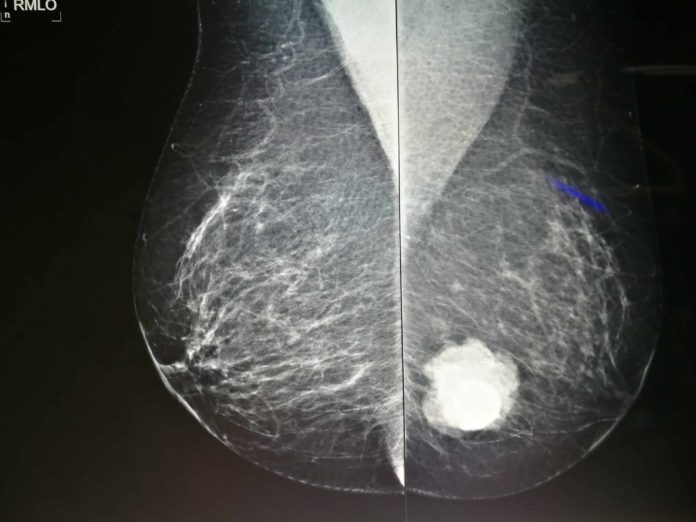Breast calcifications are tiny deposits of calcium in the breast tissue. These are more commonly found in women above the age of 50 years. Typically, breast calcifications are benign or noncancerous. However, some of them may indicate the early stages of breast cancer.
What are breast calcifications?
Breast calcifications are small calcium deposits found in the breast tissue. They appear as flecks or white spots on a mammogram (X-ray of a breast).
On a mammogram, breast calcifications may appear as:
- Macrocalcifications
Macrocalcifications appear as large white dashes or dots. In most cases, these are benign and require no further testing or follow-up.
- Microcalcifications
Microcalcifications appear as tiny white specks. Usually, these are noncancerous. However, some patterns such as such as tight clusters with irregular shapes and fine appearance — may indicate breast cancer or precancerous changes to breast tissue.
Calcifications outside of the main breast tissue
In some cases, the calcifications may develop outside of the main breast tissue. These usually form inside the blood vessels or on the skin.
What are the symptoms of breast calcifications?
Usually, breast calcifications do not show any symptoms. It is because they are too small to be felt or noticed during your routine breast examinations.
What causes breast calcifications?
You can develop breast calcifications as a result of the following possible causes:
- Ageing
- Inflammation
- Trauma from a surgery or injury
What happens when my doctor finds breast calcifications on my mammogram?
If you are diagnosed with macrocalcifications, no further testing or treatment is required as they are not harmful. However, if microcalcifications are observed on the mammogram, your doctor may recommend another mammogram for a more thorough look at the area in question. The calcifications will then be determined to be either ‘benign,’ ‘probably benign,’ or ‘suspicious.’
When to visit a doctor?
If you have a personal history of breast cancer or a family history of breast cancer, you may be at an increased risk of developing breast calcifications. In such situations, it is recommended that you visit a doctor if breast calcifications appear on the mammogram during your routine breast exam.
If the doctor suspects your initial mammogram shows concerning images, they may recommend additional magnified views to take a closer look at your breast tissue. If the additional mammograms still look concerning, the doctor may biopsy the breast tissue for a confirmed diagnosis.
The doctor may request any previous mammogram images to compare the changes in your breast tissue. These images may help the doctor determine whether or not there are any new calcifications in your breasts.
If your calcifications show the underlying causes to be benign, the doctor may recommend a follow-up in six months to perform an additional mammogram. It will help the doctor compare the changes in your breast calcifications.
Call 1860-500-1066 to book an appointment
How are breast calcifications treated?
If you have benign breast calcifications, you may not require any medical treatment. Your doctor may prescribe a follow-up in the future to check whether the calcifications have grown or changed further or not.
However, if your breast calcifications indicate cancer, then the doctor may recommend further investigations and if confirmed to be cancer , the following treatment options:
- Surgery: to surgically remove the affected breast tissue
- Chemotherapy: to destroy the cancer cells using drugs
- Radiation therapy: to kill the cancer cells with the use of intense energy beams
The doctor may prescribe a suitable treatment plan for you after considering certain factors such as size, stage, and type of your breast cancer.
Conclusion
One of the early signs of breast cancer is calcifications in the breast tissue. This makes it essential for you to have regular breast examinations, including mammograms. However, most breast calcifications turn out to be benign and do not need further tests or treatment.
If your mammogram shows suspicious images, the doctor may perform an additional mammogram or, if needed, a biopsy.
Frequently Asked Questions (FAQs)
What percentage of breast calcifications turns out to be cancerous or malignant?
Benign breast calcifications are usually harmless and require no further tests or treatment. About 2 percent of breast calcification cases have a risk of being cancerous. In other words, about 98 percent of the cases are usually non cancerous.
Can a mammogram be incorrect in identifying breast calcifications?
Sometimes, noncancerous cysts or lumps in the breasts can be mistaken to be calcifications on a mammogram. Even deodorants, powders, creams, or lotions used around the breast region can prove to be artefacts in a mammogram. This is why doctors request their patients not to use any form of product near the breasts before a mammogram.
Are there any preventive measures for breast calcifications?
Unfortunately, there is no absolute way to prevent breast calcifications. Regular breast examinations are essential to rule out the possibility of any breast cancer that could develop.


















